Metabolomics Reveals Glycerophospholipids, Peptides, and Flavonoids Contributing to Breast Meat Flavor and Benefit Properties of Beijing-You Chicken
Abstract
1. Introduction
2. Materials and Methods
2.1. Ethics Statement
2.2. Animals and Samples Collection
2.3. Meat Quality Characteristics
2.4. Sample Preparation of Metabolomics Study
2.5. UHPLC–MS/MS Analysis
2.6. Data Statistics and Bioinformatics Analysis
3. Results
3.1. Characteristics of Meat Quality during the Developmental Process
3.2. Metabolic Profiling and PLS-DA Results
3.3. Identification of Characteristic Metabolites
3.3.1. Lipids and Lipid-like Molecules
3.3.2. Organic Acids and Derivatives
3.3.3. Organooxygen Compounds and Flavonoids
3.3.4. Receiver Operating Characteristic Curve Analysis
3.4. KEGG Pathway Enrichment and Topology Analysis
4. Discussion
4.1. Lipid Compounds
4.2. Peptide Compounds
4.3. Flavonoid Compounds
5. Conclusions
Supplementary Materials
Author Contributions
Funding
Institutional Review Board Statement
Informed Consent Statement
Data Availability Statement
Acknowledgments
Conflicts of Interest
References
- Charoensin, S.; Laopaiboon, B.; Boonkum, W.; Phetcharaburanin, J.; Villareal, M.O.; Isoda, H.; Duangjinda, M. Thai Native Chicken as a Potential Functional Meat Source Rich in Anserine, Anserine/Carnosine, and Antioxidant Substances. Animals 2021, 11, 902. [Google Scholar] [CrossRef] [PubMed]
- Salter, A.M. The effects of meat consumption on global health. Rev. Sci. Tech. 2018, 37, 47–55. [Google Scholar] [CrossRef]
- Ishihara, K.; Watanabe, R.; Kato, T.; Seko, T.; Matsuda, T.; Omura, Y.; Shigemura, Y.; Kawabata, Y.; Maegawa, T. Isolation of balenine from opah (Lampris megalopsis) muscle and comparison of antioxidant and iron-chelating activities with other major imidazole dipeptides. Food Chem. 2021, 364, 130343. [Google Scholar] [CrossRef]
- Mi, S.; Shang, K.; Jia, W.; Zhang, C.-H.; Li, X.; Fan, Y.-Q.; Wang, H. Characterization and discrimination of Taihe black-boned silky fowl (Gallus gallus domesticus Brisson) muscles using LC/MS-based lipidomics. Food Res. Int. 2018, 109, 187–195. [Google Scholar] [CrossRef]
- Yang, X.; Tang, C.; Ma, B.; Zhao, Q.; Jia, Y.; Meng, Q.; Qin, Y.; Zhang, J. Identification of Characteristic Bioactive Compounds in Silkie Chickens, Their Effects on Meat Quality, and Their Gene Regulatory Network. Foods 2024, 13, 969. [Google Scholar] [CrossRef] [PubMed]
- Muroya, S.; Ueda, S.; Komatsu, T.; Miyakawa, T.; Ertbjerg, P. MEATabolomics: Muscle and meat metabolomics in domestic animals. Metabolites 2020, 10, 188. [Google Scholar] [CrossRef]
- Ramanathan, R.; Kiyimba, F.; Suman, S.P.; Mafi, G.G. The potential of metabolomics in meat science: Current applications, trends, and challenges. J. Proteomics 2023, 283–284, 104926. [Google Scholar] [CrossRef] [PubMed]
- Gu, T.; Duan, M.; Chen, L.; Tian, Y.; Xu, W.; Zeng, T.; Lu, L. Proteomic-metabolomic combination analysis reveals novel biomarkers of meat quality that differ between young and older ducks. Poult. Sci. 2024, 103, 103530. [Google Scholar] [CrossRef]
- Chen, X.; Cao, J.; Geng, A.; Zhang, X.; Wang, H.; Chu, Q.; Yan, Z.; Zhang, Y.; Liu, H.; Zhang, J. Integration of GC-MS and LC-MS for metabolite characteristics of thigh meat between fast- and slow-growing broilers at marketable age. Food Chem. 2023, 403, 134362. [Google Scholar] [CrossRef]
- Zhang, M.; Sun, L.; Su, R.; Corazzin, M.; Yang, Z.; Dou, L.; Hu, G.; Zhang, Y.; Liu, T.; Guo, Y.; et al. Widely targeted metabolomic analysis reveals the dynamic changes of metabolites during postmortem chilled aging in Mongolian sheep. Food Chem. 2024, 431, 137035. [Google Scholar] [CrossRef] [PubMed]
- Wang, H.; Wu, B.; Zhang, J.; Liu, Y.; Zhang, M.; Chen, L.; Zhao, W.; Kan, H.; Cao, C. Bamboo shoots improve the nutritional and sensory quality, and change flavor composition of chicken soup. Food Chem. X 2024, 21, 101140. [Google Scholar] [CrossRef] [PubMed]
- Ge, Y.; Gai, K.; Zheng, L.; Chen, Y.; Wang, L.; Qi, X.; Xing, K.; Wang, X.; Xiao, L.; Ni, H.; et al. HPLC-QTRAP-MS-based metabolomics approach investigates the formation mechanisms of meat quality and flavor of Beijing You chicken. Food Chem. X 2022, 17, 100550. [Google Scholar] [CrossRef] [PubMed]
- Xiao, Z.; Ge, C.; Zhou, G.; Zhang, W.; Liao, G. 1H NMR-based metabolic characterization of Chinese Wuding chicken meat. Food Chem. 2019, 274, 574–582. [Google Scholar] [CrossRef]
- Deng, S.; Xing, T.; Li, C.; Xu, X.; Zhou, G. The Effect of Breed and Age on the Growth Performance, Carcass Traits and Metabolic Profile in Breast Muscle of Chinese Indigenous Chickens. Foods 2022, 11, 483. [Google Scholar] [CrossRef] [PubMed]
- Zhang, J.; Zhuang, H.; Cao, J.; Geng, A.; Wang, H.; Chu, Q.; Yan, Z.; Zhang, X.; Zhang, Y.; Liu, H. Breast Meat Fatty Acid Profiling and Proteomic Analysis of Beijing-You Chicken During the Laying Period. Front. Vet. Sci. 2022, 9, 908862. [Google Scholar] [CrossRef]
- Zhang, J.; Chen, X.; Cao, J.; Chang, C.; Geng, A.; Wang, H.; Chu, Q.; Yan, Z.; Zhang, Y.; Liu, H. Proteomic Profiling of Thigh Meat at Different Ages of Chicken for Meat Quality and Development. Foods 2023, 12, 2901. [Google Scholar] [CrossRef]
- Zerehdaran, S.; Vereijken, A.L.J.; van Arendonk, J.A.M.; van der Waaijt, E.H. Estimation of genetic parameters for fat deposition and carcass traits in broilers. Poult. Sci. 2004, 83, 521–525. [Google Scholar] [CrossRef]
- Chen, X.; Cao, J.; Chang, C.; Geng, A.; Wang, H.; Chu, Q.; Yan, Z.; Zhang, X.; Zhang, Y.; Liu, H.; et al. Effects of Age on Compounds, Metabolites and Meat Quality in Beijing-You Chicken Breast Meat. Animals 2023, 13, 3419. [Google Scholar] [CrossRef] [PubMed]
- Li, C.; Al-Dalali, S.; Zhou, H.; Xu, B. Influence of curing on the metabolite profile of water-boiled salted duck. Food Chem. 2022, 397, 133752. [Google Scholar] [CrossRef]
- Mottram, D.S. Flavour formation in meat and meat products: A review. Food Chem. 1998, 62, 415–424. [Google Scholar] [CrossRef]
- Wood, J.D.; Enser, M.; Fisher, A.V.; Nute, G.R.; Sheard, P.R.; Richardson, R.I.; Hughes, S.I.; Whittington, F.M. Fat deposition, fatty acid composition and meat quality: A review. Meat Sci. 2008, 78, 343–358. [Google Scholar] [CrossRef] [PubMed]
- Petrova, I.; Aasen, I.M.; Rustad, T.; Eikevik, T.M. Manufacture of dry-cured ham: A review. Part 1. Biochemical changes during the technological process. Eur. Food. Res. Technol. 2015, 241, 587–599. [Google Scholar] [CrossRef]
- Fan, M.; Xiao, Q.; Xie, J.; Cheng, J.; Sun, B.; Du, W.; Wang, Y.; Wang, T. Aroma compounds in chicken broths of Beijing Youji and commercial broilers. J. Agric. Food Chem. 2018, 66, 10242–10251. [Google Scholar] [CrossRef] [PubMed]
- Carrizo, D.; Chevallier, O.P.; Woodside, J.V.; Brennan, S.F.; Cantwell, M.M.; Cuskelly, G.; Elliott, C.T. Untargeted metabolomic analysis of human serum samples associated with exposure levels of Persistent organic pollutants indicate important perturbations in Sphingolipids and Glycerophospholipids levels. Chemosphere 2017, 168, 731–738. [Google Scholar] [CrossRef] [PubMed]
- Li, J.; Li, Z.; Ran, J.; Yang, C.; Lin, Z.; Liu, Y. LC/MS-based lipidomics to characterize breed-specific and tissue-specific lipid composition of chicken meat and abdominal fat. LWT 2022, 163, 113611. [Google Scholar] [CrossRef]
- Hsu, C.-L.; Yen, G.-C. Ganoderic Acid and Lucidenic Acid (Triterpenoid). Enzymes 2014, 36, 33–56. [Google Scholar] [CrossRef] [PubMed]
- Gill, B.S.; Navgeet; Kumar, S. Antioxidant potential of ganoderic acid in Notch-1 protein in neuroblastoma. Mol. Cell Biochem. 2019, 456, 1–14. [Google Scholar] [CrossRef]
- Zheng, C.; Lv, S.; Ye, J.; Zou, L.; Zhu, K.; Li, H.; Dong, Y.; Li, L. Metabolomic Insights into the Mechanisms of Ganoderic Acid: Protection against α-Amanitin-Induced Liver Injury. Metabolites 2023, 13, 1164. [Google Scholar] [CrossRef]
- Xu, L.; Yan, L.; Huang, S. Ganoderic acid A against cyclophosphamide-induced hepatic toxicity in mice. J. Biochem. Mol. Toxicol. 2019, 33, e22271. [Google Scholar] [CrossRef]
- Ogasawara, M.; Katsumata, T.; Egi, M. Taste properties of Maillard-reaction products prepared from 1000 to 5000 Da peptide. Food Chem. 2006, 99, 600–604. [Google Scholar] [CrossRef]
- Zhou, R.; Grant, J.; Goldberg, E.M.; Ryland, D.; Aliani, M. Investigation of low molecular weight peptides (<1 kDa) in chicken meat and their contribution to meat flavor formation. J. Sci. Food Agric. 2019, 99, 1728–1739. [Google Scholar] [CrossRef] [PubMed]
- Tamura, M.; Nakatsuka, T.; Tada, M.; Kawasaki, Y.; Kikuchi, E.; Okai, H. The relationship between taste and primary structure of “delicious peptide” (Lys-Gly-Asp-Glu-GluSer-Leu-Ala) from beef soup. Agric. Biol. Chem. 1989, 53, 319–325. [Google Scholar] [CrossRef]
- Kubát, M.; Roušarová, E.; Roušar, T.; Česla, P. Recent advances in separation methods for characterization of glutathione metabolism and dietary supplementation. TrAC Trends Anal. Chem. 2024, 176, 117751. [Google Scholar] [CrossRef]
- Mecchi, E.P.; Pippen, E.L.; Lineweaver, H. Origin of Hydrogen Sulfide in Heated Chicken Muscle. J. Food Sci. 1964, 29, 393–399. [Google Scholar] [CrossRef]
- Carnegie, P.R.; IIic, M.Z.; Etheridge, M.O.; Collins, M.G. Improved high-performance liquid chromatographic method for analysis of histidine dipeptides anserine, carnosine and balenine present in fresh meat. J. Chromatogr. 1983, 261, 153–157. [Google Scholar] [CrossRef]
- Peiretti, P.G.; Medana, C.; Visentin, S.; Giancotti, V.; Zunino, V.; Meineri, G. Determination of carnosine, anserine, homocarnosine, pentosidine and thiobarbituric acid reactive substances contents in meat from different animal species. Food Chem. 2011, 126, 1939–1947. [Google Scholar] [CrossRef] [PubMed]
- Freund, M.A.; Chen, B.; Decker, E.A. The Inhibition of Advanced Glycation End Products by Carnosine and Other Natural Dipeptides to Reduce Diabetic and Age-Related Complications. Compr. Rev. Food Sci. Food Saf. 2018, 17, 1367–1378. [Google Scholar] [CrossRef] [PubMed]
- Barbaresi, S.; Maertens, L.; Claeys, E.; Derave, W.; De Smet, S. Differences in muscle histidine-containing dipeptides in broilers. J. Sci. Food Agric. 2019, 99, 5680–5686. [Google Scholar] [CrossRef] [PubMed]
- Kojima, S.; Saegusa, H.; Sakata, M. Histidine-containing dipeptide concentration and antioxidant effects of meat extracts from silky fowl: Comparison with meat-type chicken breast and thigh meats. Food Sci. Technol. Res. 2014, 20, 621–628. [Google Scholar] [CrossRef]
- Hipkiss, A.R.; Cartwright, S.P.; Bromley, C.; Gross, S.R.; Bill, R.M. Carnosine: Can understanding its actions on energy metabolism and protein homeostasis inform its therapeutic potential? Chem. Cent. J. 2013, 7, 38. [Google Scholar] [CrossRef]
- Yang, B.; Liu, H.; Yang, J.; Gupta, V.K.; Jiang, Y. New insights on bioactivities and biosynthesis of flavonoid glycosides. Trends Food Sci. Technol. 2018, 79, 116–124. [Google Scholar] [CrossRef]
- Chen, L.; Cao, H.; Huang, Q.; Xiao, J.; Teng, H. Absorption, metabolism and bioavailability of flavonoids: A review. Crit. Rev. Food Sci. Nutr. 2022, 62, 7730–7742. [Google Scholar] [CrossRef] [PubMed]
- Amiot, M.-J.; Fleuriet, A.; Macheix, J.-J. Accumulation of oleuropein derivatives during olive maturation. Phytochemistry 1989, 28, 67–69. [Google Scholar] [CrossRef]
- Czerwińska, M.; Kiss, A.K.; Naruszewicz, M. A comparison of antioxidant activities of oleuropein and its dialdehydic derivative from olive oil, oleacein. Food Chem. 2012, 131, 940–947. [Google Scholar] [CrossRef]
- Ortiz, A.C.; Fideles, S.O.M.; Reis, C.H.B.; Bellini, M.Z.; Pereira, E.S.B.M.; Pilon, J.P.G.; de Marchi, M.Â.; Detregiachi, C.R.P.; Flato, U.A.P.; Trazzi, B.F.M.; et al. Therapeutic Effects of Citrus Flavonoids Neohesperidin, Hesperidin and Its Aglycone, Hesperetin on Bone Health. Biomolecules 2022, 12, 626. [Google Scholar] [CrossRef]
- Xia, X.; Fu, J.; Song, X.; Shi, Q.; Su, C.; Song, E.; Song, Y. Neohesperidin dihydrochalcone down-regulates MyD88-dependent and -independent signaling by inhibiting endotoxin-induced trafficking of TLR4 to lipid rafts. Free Radic. Biol. Med. 2015, 89, 522–532. [Google Scholar] [CrossRef] [PubMed]
- Gordo, J.; Máximo, P.; Cabrita, E.; Lourenço, A.; Oliva, A.; Almeida, J.; Filipe, M.; Cruz, P.; Barcia, R.; Santos, M.; et al. Thymus mastichina: Chemical constituents and their anti-cancer activity. Nat. Prod. Commun. 2012, 7, 1491–1494. [Google Scholar] [CrossRef]
- Kumar, D.; Sharma, P.; Singh, H.; Nepali, K.; Gupta, G.K.; Jain, S.K.; Ntie-Kang, F. The value of pyrans as anticancer scafolds in medicinal chemistry. RSC Adv. 2017, 7, 36977–36999. [Google Scholar] [CrossRef]
- Nabavi, S.M.; Habtemariam, S.; Daglia, M.; Nabavi, S.F. Apigenin and Breast Cancers: From Chemistry to Medicine. Anticancer Agents Med. Chem. 2015, 15, 728–735. [Google Scholar] [CrossRef]
- Huang, C.; Wei, Y.-X.; Shen, M.-C.; Tu, Y.-H.; Wang, C.-C.; Huang, H.-C. Chrysin, abundant in Morinda citrifolia fruit water-EtOAc extracts, combined with apigenin synergistically induced apoptosis and inhibited migration in human breast and liver cancer cells. J. Agric. Food Chem. 2016, 64, 4235–4245. [Google Scholar] [CrossRef]
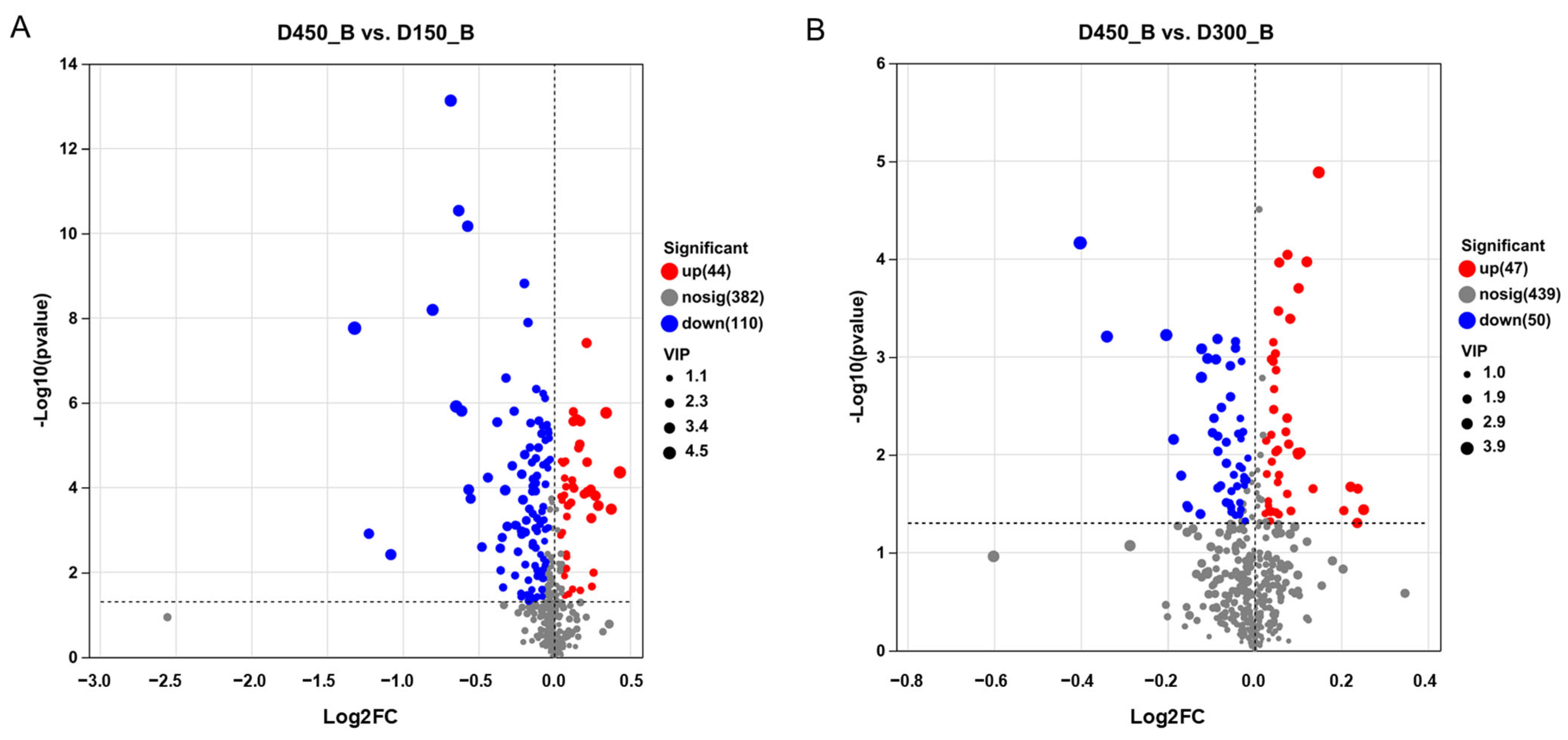
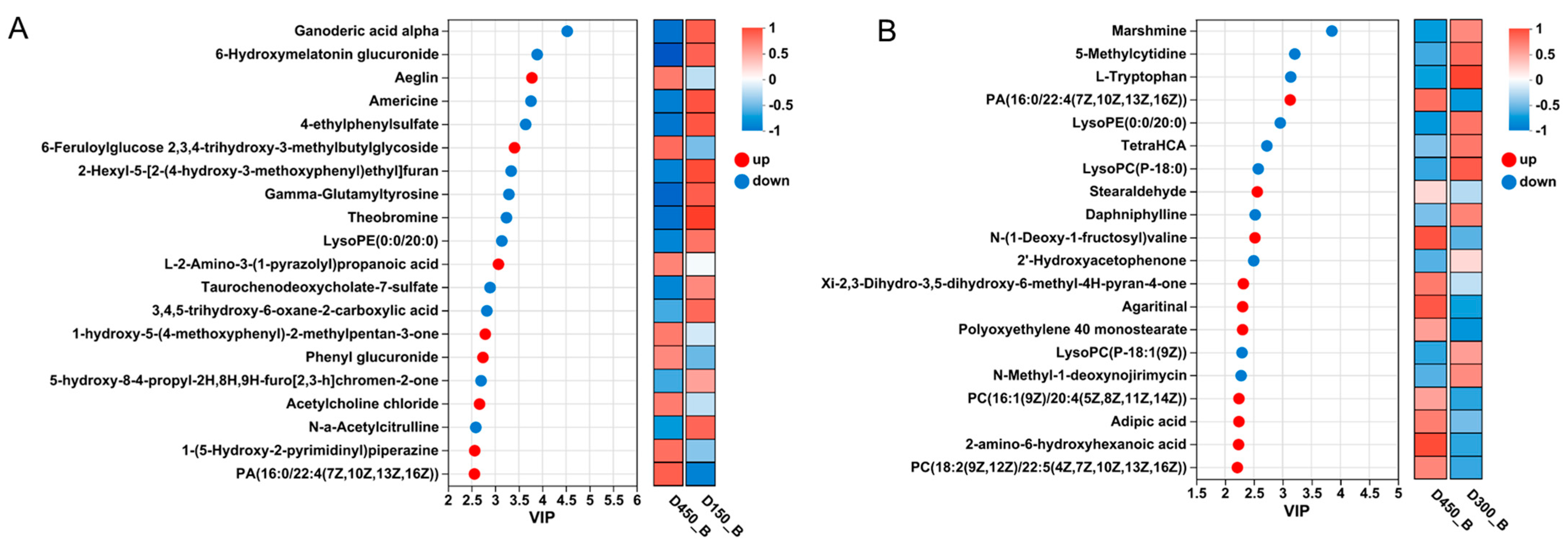

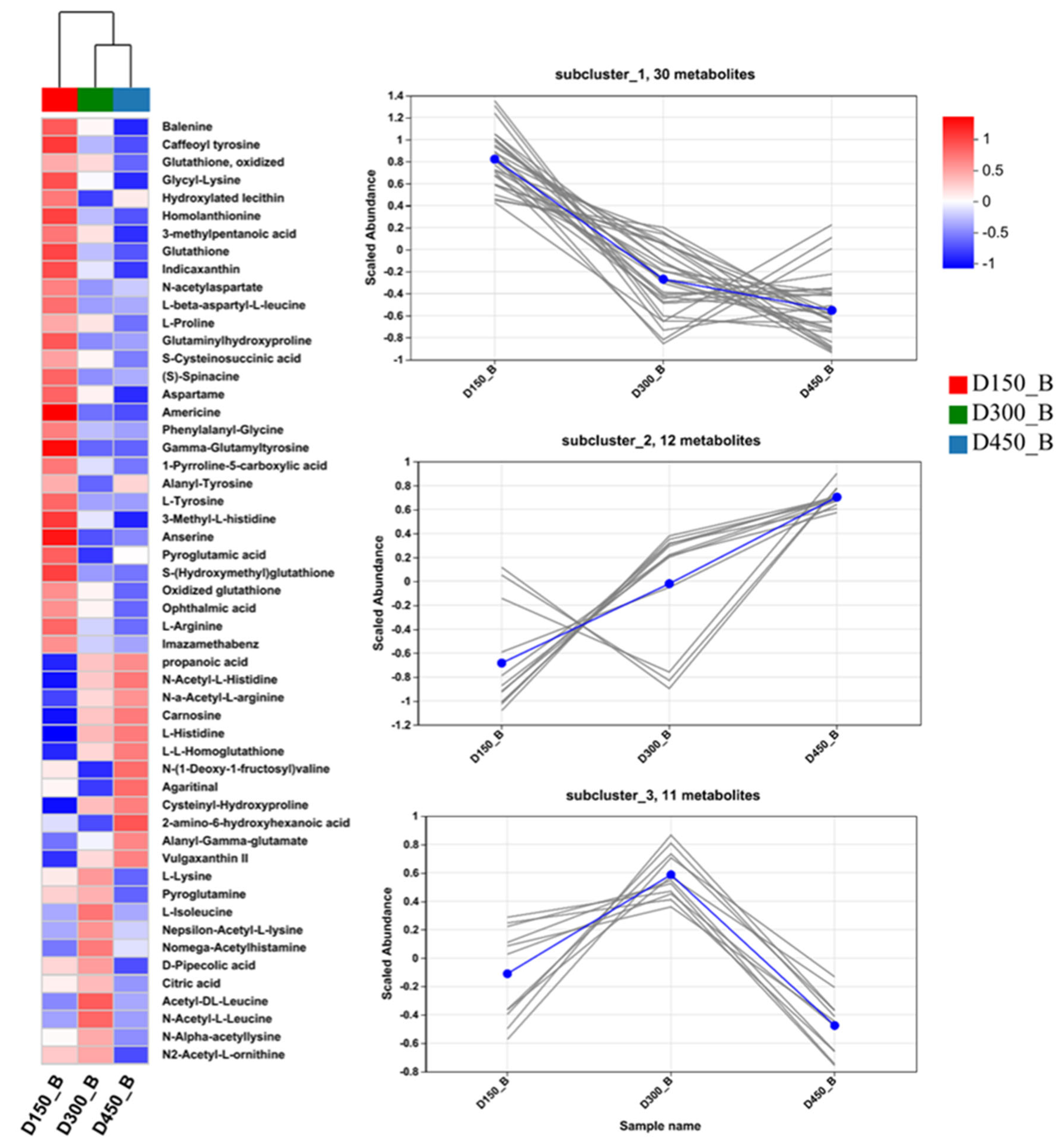
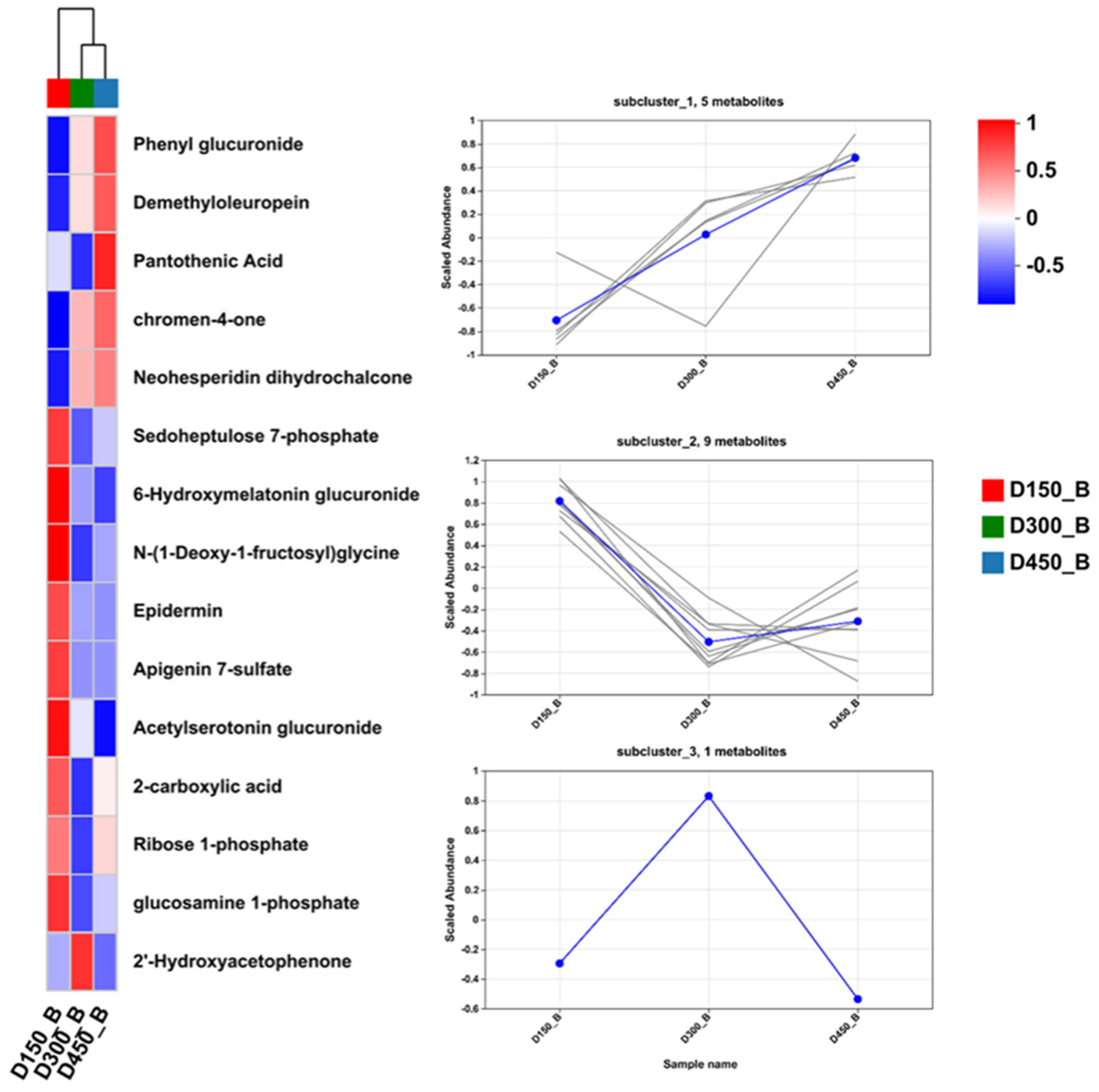

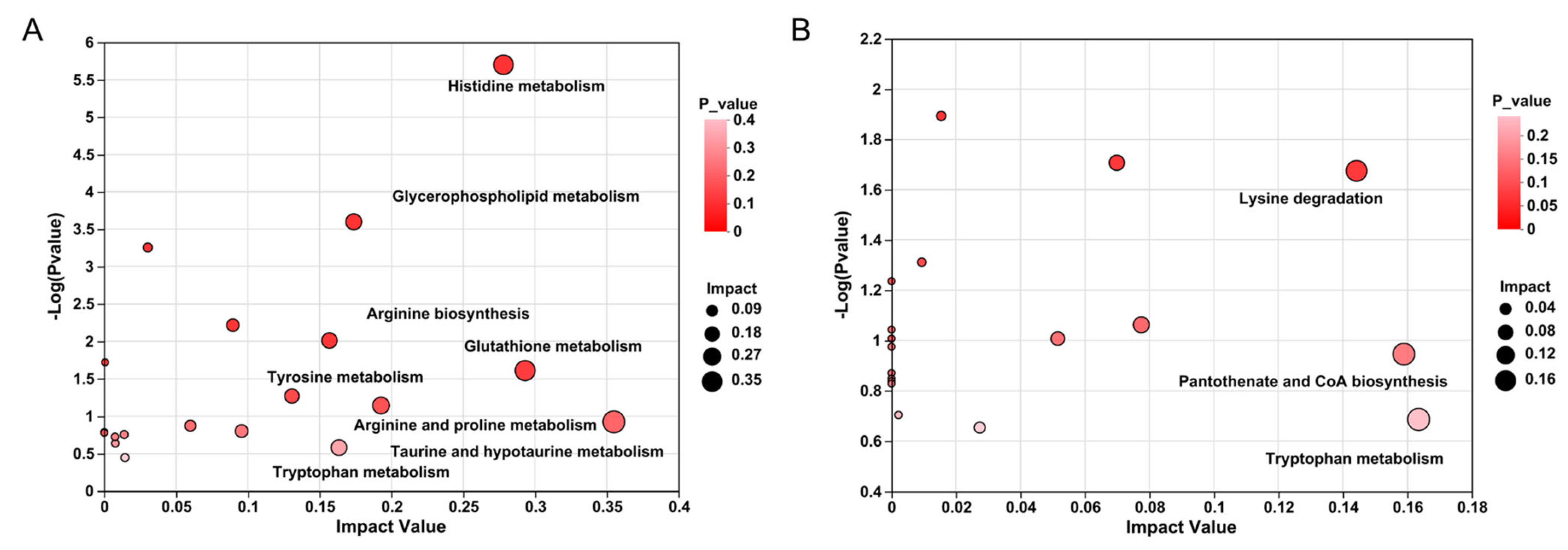
| Traits 2 | D150 | D300 | D450 |
|---|---|---|---|
| live body weight (g) | 1344 ± 63 c | 1951 ± 266 b | 2228 ± 294 a |
| dry matter (%) | 24.91 ± 0.99 c | 28.45 ± 0.97 b | 29.19 ± 1.02 a |
| IMF (%) | 1.36 ± 0.53 b | 3.10 ± 0.90 a | 3.25 ± 1.55 a |
| Peptides | |||
| Ans (mg/g) | 9.54 ± 0.58 a | 7.58 ± 0.97 b | 6.77 ± 1.11 c |
| Car (mg/g) | 1.36 ± 0.74 c | 4.63 ± 1.21 b | 5.70 ± 1.12 a |
| Free Amino Acids | |||
| P-Ser (mg/g) | 0.019 ± 0.004 a | 0.01 ± 0.003 b | 0.018 ± 0.005 a |
| Tau (mg/g) | 0.083 ± 0.021 a | 0.048 ± 0.007 b | 0.048 ± 0.007 b |
| Asp (mg/g) | 0.01 ± 0.013 b | 0.013 ± 0.005 b | 0.036 ± 0.012 a |
| Thr (mg/g) | 0.026 ± 0.01 b | 0.068 ± 0.052 a | 0.042 ± 0.015 b |
| Ser (mg/g) | 0.049 ± 0.012 | 0.056 ± 0.012 | 0.049 ± 0.006 |
| Glu (mg/g) | 0.061 ± 0.02 b | 0.085 ± 0.029 a | 0.07 ± 0.025 ab |
| Gly (mg/g) | 0.031 ± 0.009 c | 0.045 ± 0.013 a | 0.038 ± 0.007 b |
| Ala (mg/g) | 0.052 ± 0.016 c | 0.081 ± 0.02 a | 0.068 ± 0.013 b |
| Val (mg/g) | 0.018 ± 0.006 b | 0.037 ± 0.009 a | 0.03 ± 0.007 c |
| Met (mg/g) | 0.003 ± 0.001 b | 0.003 ± 0.002 b | 0.009 ± 0.002 a |
| Ile (mg/g) | 0.003 ± 0.001 b | 0.003 ± 0.002 b | 0.009 ± 0.002 a |
| Leu (mg/g) | 0.017 ± 0.003 b | 0.042 ± 0.01 a | 0.038 ± 0.008 a |
| Tyr (mg/g) | 0.016 ± 0.002 b | 0.021 ± 0.005 a | 0.022 ± 0.003 a |
| Phe (mg/g) | 0.011 ± 0.003 b | 0.019 ± 0.004 a | 0.02 ± 0.005 a |
| b-Ala (mg/g) | 0.052 ± 0.014 a | 0.024 ± 0.011 b | 0.023 ± 0.013 b |
| Lys (mg/g) | 0.032 ± 0.015 b | 0.047 ± 0.014 a | 0.033 ± 0.009 b |
| His (mg/g) | 0.007 ± 0.001 b | 0.019 ± 0.005 a | 0.017 ± 0.003 a |
| Arg (mg/g) | 0.024 ± 0.01 c | 0.052 ± 0.017 b | 0.065 ± 0.014 a |
| Pro (mg/g) | 0.021 ± 0.03 | 0.029 ± 0.005 | 0.022 ± 0.004 |
| Total Amino Acids (mg/g) | 0.535 ± 0.072 b | 0.701 ± 0.129 a | 0.657 ± 0.084 a |
Disclaimer/Publisher’s Note: The statements, opinions and data contained in all publications are solely those of the individual author(s) and contributor(s) and not of MDPI and/or the editor(s). MDPI and/or the editor(s) disclaim responsibility for any injury to people or property resulting from any ideas, methods, instructions or products referred to in the content. |
© 2024 by the authors. Licensee MDPI, Basel, Switzerland. This article is an open access article distributed under the terms and conditions of the Creative Commons Attribution (CC BY) license (https://creativecommons.org/licenses/by/4.0/).
Share and Cite
Zhang, J.; Chen, X.; Cao, J.; Geng, A.; Chu, Q.; Yan, Z.; Zhang, Y.; Liu, H. Metabolomics Reveals Glycerophospholipids, Peptides, and Flavonoids Contributing to Breast Meat Flavor and Benefit Properties of Beijing-You Chicken. Foods 2024, 13, 2549. https://doi.org/10.3390/foods13162549
Zhang J, Chen X, Cao J, Geng A, Chu Q, Yan Z, Zhang Y, Liu H. Metabolomics Reveals Glycerophospholipids, Peptides, and Flavonoids Contributing to Breast Meat Flavor and Benefit Properties of Beijing-You Chicken. Foods. 2024; 13(16):2549. https://doi.org/10.3390/foods13162549
Chicago/Turabian StyleZhang, Jian, Xia Chen, Jing Cao, Ailian Geng, Qin Chu, Zhixun Yan, Yao Zhang, and Huagui Liu. 2024. "Metabolomics Reveals Glycerophospholipids, Peptides, and Flavonoids Contributing to Breast Meat Flavor and Benefit Properties of Beijing-You Chicken" Foods 13, no. 16: 2549. https://doi.org/10.3390/foods13162549
APA StyleZhang, J., Chen, X., Cao, J., Geng, A., Chu, Q., Yan, Z., Zhang, Y., & Liu, H. (2024). Metabolomics Reveals Glycerophospholipids, Peptides, and Flavonoids Contributing to Breast Meat Flavor and Benefit Properties of Beijing-You Chicken. Foods, 13(16), 2549. https://doi.org/10.3390/foods13162549







